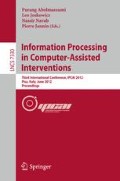Abstract
We consider the problem of classifying surgical gestures and skill level in robotic surgical tasks. Prior work in this area models gestures as states of a hidden Markov model (HMM) whose observations are discrete, Gaussian or factor analyzed. While successful, these approaches are limited in expressive power due to the use of discrete or Gaussian observations. In this paper, we propose a new model called sparse HMMs whose observations are sparse linear combinations of elements from a dictionary of basic surgical motions. Given motion data from many surgeons with different skill levels, we propose an algorithm for learning a dictionary for each gesture together with an HMM grammar describing the transitions among different gestures. We then use these dictionaries and the grammar to represent and classify new motion data. Experiments on a database of surgical motions acquired with the da Vinci system show that our method performs on par with or better than state-of-the-art methods.This suggests that learning a grammar based on sparse motion dictionaries is important in gesture and skill classification.
Access this chapter
Tax calculation will be finalised at checkout
Purchases are for personal use only
Preview
Unable to display preview. Download preview PDF.
References
Barden, C., Specht, M., McCarter, M., Daly, J., Fahey, T.: Effects of limited work hours on surgical training. Obstetrical & Gynecological Survey 58(4), 244–245 (2003)
Datta, V., Mackay, S., Mandalia, M., Darzi, A.: The use of electromagnetic motion tracking analysis to objectively measure open surgical skill in laboratory-based model. Journal of the American College of Surgery 193, 479–485 (2001)
Judkins, T., Oleynikov, D., Stergiou, N.: Objective evaluation of expert and novice performance during robotic surgical training tasks. Surgical Endoscopy 1(4) (2008)
Richards, C., Rosen, J., Hannaford, B., Pellegrini, C., Sinanan, M.: Skills evaluation in minimally invasive surgery using force/torque signatures. Surgical Endoscopy 14, 791–798 (2000)
Yamauchi, Y., Yamashita, J., Morikawa, O., Hashimoto, R., Mochimaru, M., Fukui, Y., Uno, H., Yokoyama, K.: Surgical Skill Evaluation by Force Data for Endoscopic Sinus Surgery Training System. In: Dohi, T., Kikinis, R. (eds.) MICCAI 2002. LNCS, vol. 2488, pp. 44–51. Springer, Heidelberg (2002)
Rosen, J., Hannaford, B., Richards, C., Sinanan, M.: Markov modeling of minimally invasive surgery based on tool/tissue interaction and force/torque signatures for evaluating surgical skills. IEEE Trans. Biomedical Eng. 48(5), 579–591 (2001)
Reiley, C.E., Hager, G.D.: Task versus Subtask Surgical Skill Evaluation of Robotic Minimally Invasive Surgery. In: Yang, G.-Z., Hawkes, D., Rueckert, D., Noble, A., Taylor, C. (eds.) MICCAI 2009, Part I. LNCS, vol. 5761, pp. 435–442. Springer, Heidelberg (2009)
Rosen, J., Solazzo, M., Hannaford, B., Sinanan, M.: Task decomposition of laparo-scopic surgery for objective evaluation of surgical residents’ learning curve using hidden Markov model. Computer Aided Surgery 7(1), 49–61 (2002)
Varadarajan, B., Reiley, C., Lin, H., Khudanpur, S., Hager, G.: Data-Derived Models for Segmentation with Application to Surgical Assessment and Training. In: Yang, G.-Z., Hawkes, D., Rueckert, D., Noble, A., Taylor, C. (eds.) MICCAI 2009, Part I. LNCS, vol. 5761, pp. 426–434. Springer, Heidelberg (2009)
Varadarajan, B.: Learning and Inference Algorithms for Dynamical System Models of Dextrous Motion. PhD thesis, Johns Hopkins University (2011)
Leong, J.J.H., Nicolaou, M., Atallah, L., Mylonas, G.P., Darzi, A.W., Yang, G.-Z.: HMM Assessment of Quality of Movement Trajectory in Laparoscopic Surgery. In: Larsen, R., Nielsen, M., Sporring, J. (eds.) MICCAI 2006. LNCS, vol. 4190, pp. 752–759. Springer, Heidelberg (2006)
Lin, H.C., Shafran, I., Murphy, T.E., Okamura, A.M., Yuh, D.D., Hager, G.D.: Automatic Detection and Segmentation of Robot-Assisted Surgical Motions. In: Duncan, J.S., Gerig, G. (eds.) MICCAI 2005. LNCS, vol. 3749, pp. 802–810. Springer, Heidelberg (2005)
Aharon, M., Elad, M., Bruckstein, A.M.: K-SVD: An algorithm for designing overcomplete dictionaries for sparse representation. IEEE Trans. on Signal Processing 54(11), 4311–4322 (2006)
Forney Jr., G.D.: The Viterbi algorithm. Proceedings of the IEEE 61(3) (1973)
Baum, L.E., Petrie, T., Soules, G., Weiss, N.: A maximization technique occurring in the statistical analysis of probabilistic functions of Markov chains. Ann. Math. Statist. 41(1), 164–171 (1970)
Chen, S.S., Donoho, D.L., Saunders, M.A.: Atomic decomposition by basis pursuit. SIAM J. Sci. Comput. 20, 33–61 (1998)
Tropp, J.A., Gilbert, A.C.: Signal recovery from random measurements via orthogonal matching pursuit. IEEE Trans. on Information Theory 53(12), 4655–4666 (2007)
Dosis, A., Bello, F., Gillies, D., Undre, S., Aggarwal, R., Darzi, A.: Laparoscopic task recognition using hidden markov models. Studies in Health Technology and Informatics 111, 115–122 (2005)
Tipping, M., Bishop, C.: Probabilistic principal component analysis. Journal of the Royal Statistical Society 61(3), 611–622 (1999)
Tipping, M., Bishop, C.: Mixtures of probabilistic principal component analyzers. Neural Computation 11(2), 443–482 (1999)
McLachlan, G.J., Peel, D., R.W.B.: Modelling high-dimensional data by mixture of factor analyzers. Computational Statistics and Data Analysis 41, 379–388 (2003)
Olshausen, B.A., Field, B.J.: Sparse coding with an overcomplete basis set: a strategy employed by V1? Vision Research (1997)
Engan, K., Aase, S.O., Husoy, J.H.: Method of optimal directions for frame design. In: IEEE International Conference on Acoustics, Speech, and Signal Processing (1999)
Reiley, C.E., Lin, H.C., Varadarajan, B., Vagolgyi, B., Khudanpur, S., Yuh, D.D., Hager, G.D.: Automatic recognition of surgical motions using statistical modeling for capturing variability. In: Medicine Meets Virtual Reality, pp. 396–401 (2008)
Lin, H.: Structure in Surgical Motion. PhD thesis. Johns Hopkins University (2010)
Author information
Authors and Affiliations
Editor information
Editors and Affiliations
Rights and permissions
Copyright information
© 2012 Springer-Verlag Berlin Heidelberg
About this paper
Cite this paper
Tao, L., Elhamifar, E., Khudanpur, S., Hager, G.D., Vidal, R. (2012). Sparse Hidden Markov Models for Surgical Gesture Classification and Skill Evaluation. In: Abolmaesumi, P., Joskowicz, L., Navab, N., Jannin, P. (eds) Information Processing in Computer-Assisted Interventions. IPCAI 2012. Lecture Notes in Computer Science, vol 7330. Springer, Berlin, Heidelberg. https://doi.org/10.1007/978-3-642-30618-1_17
Download citation
DOI: https://doi.org/10.1007/978-3-642-30618-1_17
Publisher Name: Springer, Berlin, Heidelberg
Print ISBN: 978-3-642-30617-4
Online ISBN: 978-3-642-30618-1
eBook Packages: Computer ScienceComputer Science (R0)

